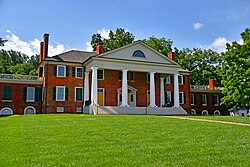
Back Montpelier (Virginia) German مونپلیه (اورنج، ویرجینیا) Persian モントピリア (ジェームズ・マディソンの邸宅) Japanese Montpelier (landgoed) Dutch Montpelier Turkish مونٹپیلیئر (اورنج، ورجینیا) Urdu
Montpelier (James Madison House) | |
 | |
 Interactive map showing Montpelier's location | |
| Location | Orange County, Virginia |
|---|---|
| Nearest city | Orange, Virginia |
| Coordinates | 38°13′11″N 78°10′10″W / 38.21972°N 78.16944°W |
| Area | 2,650 acres (1,070 ha) |
| Built | c. 1764 |
| Website | montpelier.org |
| NRHP reference No. | 66000843 |
| VLR No. | 068-0030 |
| Significant dates | |
| Added to NRHP | October 15, 1966[1] |
| Designated NHLDCP | December 19, 1960[3] |
| Designated VLR | September 9, 1969[2] |
James Madison's Montpelier, located in Orange County, Virginia, was the plantation house of the Madison family, including Founding Father and fourth president of the United States James Madison and his wife, Dolley. The 2,650-acre (1,070 ha) property is open seven days a week.
Montpelier was declared a National Historic Landmark and listed on the National Register of Historic Places in 1966. It was included in the Madison-Barbour Rural Historic District in 1991. In 1983, the last private owner of Montpelier, Marion duPont Scott, bequeathed the estate to the National Trust for Historic Preservation.
The National Trust for Historic Preservation (NTHP) has owned and operated the estate since 1984. In 2000, The Montpelier Foundation formed with the goal of transforming James Madison's historic estate into a dynamic cultural institution. From 2003 to 2008 the NTHP carried out a major restoration, in part to return the mansion to its original size of 22 rooms as it was during the years when it was occupied by James and Dolley Madison. Extensive interior and exterior work was done during the restoration.
Archeological investigations in the 21st century revealed new information about African-American life at the plantation, and a gift from philanthropist David Rubenstein enabled the National Trust to restore the slave quarters in the South Yard and open a slavery exhibition, The Mere Distinction of Colour, in 2017. In June 2021, the Montpelier Foundation approved bylaws to share in governance of the estate with the Montpelier Descendants Committee, composed of descendants of those enslaved at the estate.[4][5] After some controversy,[6] the Montpelier Descendants Committee achieved parity within the Foundation,[7] holding 14 of 25 seats on the board as of May 2022,[8] including the chair.[9]
- ^ "National Register Information System". National Register of Historic Places. National Park Service. January 23, 2007.
- ^ "Virginia Landmarks Register". Virginia Department of Historic Resources. Retrieved June 5, 2013.
- ^ "Montpelier (James Madison House)". National Historic Landmark summary listing. National Park Service. Archived from the original on June 24, 2008. Retrieved August 29, 2008.
- ^ "'Structural Parity' in Unprecedented Board Restructuring" (Press release). Virginia: Montpelier Foundation. June 18, 2021. Archived from the original on June 18, 2021. Retrieved June 27, 2021.
- ^ Jones, Brenda (June 18, 2021). "James Madison's Montpelier Votes to Share Power With Descendants of Plantations Enslaved People" (Press release). Orange, Virginia: Montpelier Foundation. National Trust for Historic Preservation. Archived from the original on June 25, 2021. Retrieved June 27, 2021.
- ^ Roberts, Nigel (August 10, 2022). "How Descendants Of James Madison's Montpelier's Enslaved Gained Shared Governance Of Historic Plantation". Retrieved November 27, 2022.
- ^ "Montpelier Descendants Committee". Montpelier Descendants. Retrieved November 27, 2022.
- ^ Schneider, Gregory S. (May 16, 2022). "In reversal, Montpelier appoints directors from descendants of the enslaved". The Washington Post. Retrieved January 16, 2023.
- ^ "Board Acts Quickly to Resolve Crisis" (Press release). James Madison's Montpelier. May 25, 2022. Retrieved January 16, 2023.
© MMXXIII Rich X Search. We shall prevail. All rights reserved. Rich X Search